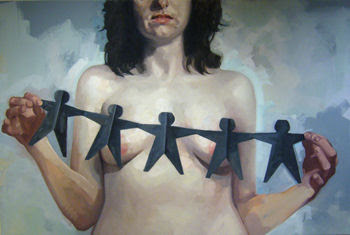Shelly Voorhees at BlackRock
Just a few weeks ago I reminded all of you that BlackRock Center for the Arts in Germantown, MD has one of the most beautiful and dramatic gallery spaces in the region, and the other day I happened to be in that area again and dropped in to see the new show there.
Currently on exhibition are the monochromatic ethereal paintings of Shelly Voorhees, on exhibition through August 28.
It's hard to describe this exhibition without using synonyms for the word "ethereal", and since I've already dropped that adjective once, plant that description in your mind and walk with me through words.
As one enters the very large and very tall space that is the gallery at Blackrock, Voorhees' paintings, most of which are very large, fit well into the space, not only because of sheer scale, but also because of the monochromatic uniformity that they present. Until you look to your left, that is.
Until you look to your left, that is.
That wall hosts a series of very small, we're talking a couple of inches or so, very well done, and very attractive set of miniature portraits. See some of them here. Every single one of them is a jewel and showcases a very strong technical talent by Voorhees.
You see, as any painter will tell you, it is more often than not harder to create a small, in this case, tiny, work of art that carries a punch, than a larger one. Voorhees succeeds admirably and the wall of tiny works resonates in a visual paradox in this very large gallery.
Salvador Dali said it best when he said: "If you can't paint well, then paint big."
Voorhees has titled the exhibition "Apparitions" and writes about it:
This exhibition is a black and white mixed-media portraiture series of female spirits dynamically represented in moments of contemplation and emotional transition. Besides the apparitional theme, the incorporation of specific artistic elements of texture, depth, layers, luminosity, and motion, are equally important in the expressing of the merging of life's energy with the portraits ethereal.While I was there looking at the show, I sat down and observed several families who were walking through the exhibition. The comments from the children seemed to imply that the artist had achieved her goal, as the comments all had a sense of the unusual, ghostly and transitory. The adults mostly commented on the beauty of the works themselves.
In this series, I've incorporated the expansive landscape views from my window of Lake Champlain. The natural background of the lake balances the figures beauty with their emotions. The power of the waters help to calm the viewer, and the abstracted horizontal strokes reminds us of the life that moves through us. The women are painted thinly veiled so that you can see the abstracted landscapes through their bodily shapes. I found interest in the translucent figures appearing as if their souls still remain with us. I've exemplified my own take on the traditional idea of apparitions, attempting to humanize the spirits by painting them with simple gestures in unguarded moments of contemplation and transition. These moments are expressions of the duality between movement and the still,landscape and the figure, real and the ethereal. They are psychological portraits that reflect the emotional undercurrents present in even the most unremarkable moments in life, they give tribute to women and the essence of their spirit that is eternal.
Therein lies the key to viewing all these works at once. Voorhees uses resin and acrylic skillfully to deliver a sense of atmospheric presence in the paintings that offer the women subjects as almost a transition in the fog of grayscales, rather than a physical object. She has also chosen a sort of 19th century romantic period "look" for her models, that gives us the kind of women who Julia Margaret Cameron would have loved to photograph.

Shelly Voorhees, Waiting, Acrylic/Resin, 38x26 inches
And yet, as soon as I state this I am confronted by a sense of the opposite in the sense that there also seems to be a modernistic transition in the "look" of the women, trapped in my mind in a 19th century gaze and feel, to a sense of today looking from the past. This is perhaps most visible in "Waiting," which shows a very young 21st century woman lost in 19th century thoughts.
See the show online here.






















